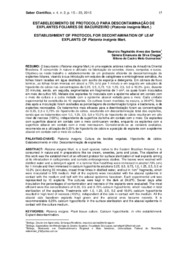Establishment of protocol for decontamination of leaf explants of Platonia insignis Mart.
Establishment of protocol for decontamination of leaf explants of Platonia insignis Mart.
Autoria: SANTOS, M. R. A. dos; CHAGAS, S. E. da S.; GUIMARÃES, M. de C. M.
Resumo: The objective of this work was the establishment of an efficient protocol for surface sterilization of leaf explants aiming at its introduction in callogenesis and somatic embryogenesis studies. The leaves were washed with distilled water and a detergent agent. In a laminar flow hood they were immersed in alcohol 70% (v/v) for 1 minute and then immersed in calcium hypochlorite solutions 0.25, 0.5, 0.75, 1.0, 1.25, 2.5, 5.0 or 10.0% (w/v) during 30 minutes, rinsed three times in distilled water, and cut in 1cm2 fragments, which were inoculated in MS medium. Half of the explants were inoculated with the abaxial epidermis in contact with the medium and half with the adaxial epidermis facedown. Each experimental unit was represented by 10 explants. The cultures were kept in the dark at 24±2ºC. Seven days after inoculation the percentages of contamination and necrosis of the explants were evaluated. The most efficient were the concentrations of 0.25, 0.5 and 0.75% calcium hypochlorite, which resulted in total sterilization of the explants. Treatments with 1.0, 1.25, 2.5, 5.0 and 10.0% calcium hypochlorite resulted in high level of necrosis (100%), independent of the side in contact with the medium. All the abaxial side facedown explants kept green and the adaxial ones became necrotic. It is recommendable 0.25% calcium hypochlorite in the surface sterilization and the abaxial epidermis in contact with the culture medium.
Ano de publicação: 2015
Tipo de publicação: Artigo de periódico
Unidade: Embrapa Rondônia
Observações
1 - Por padrão são exibidas publicações dos últimos 20 anos. Para encontrar publicações mais antigas, configure o filtro ano de publicação, colocando o ano a partir do qual você deseja encontrar publicações. O filtro está na coluna da esquerda na busca acima.
2 - Para ler algumas publicações da Embrapa (apenas as que estão em formato ePub), é necessário ter, no celular ou computador, um desses softwares gratuitos. Sistemas Android: Google Play Livros; IOS: iBooks; Windows e Linux: software Calibre.
Acesse outras publicações
Acesse a Base de Dados da Pesquisa Agropecuária (BDPA) para consultar o acervo completo das bibliotecas da Embrapa.

